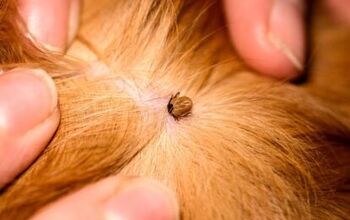What is Cushing’s Disease in Dogs?

Cushing’s disease in dogs (also known as Hyperadrenocorticism and Cushing’s syndrome) can be traced a canine’s adrenal glands, which are located just above each kidney. You’ll often see this disease in older dogs and you may mistake it for the aging process. If you think your furry friend is suffering from this disease or your vet has given you a positive diagnosis, there is a lot you can learn to help your pet and choose the best course of treatment.
Cushing’s disease in dogs is brought about by an excess of circulating cortisol hormone. This causes functional tumors to form on a dog’s adrenal or pituitary glands. There are three different types of canine Cushing’s disease: pituitary-based, adrenal-based and iatrogenic. Chronic and slowly progressive, each type presents the same clinical signs and all need treatment. When the disease is iatrogenic, it means that it was brought on by drugs prescribed for other illness that as a side effect, stimulated excessive adrenal hormone production.
Seen most often in small dogs weighing less than 45 pounds, this disease appears in canines over the age of six. Cushing’s disease in dogs is slightly higher in females than males, and seems to affect Beagles, Boxers, Dachshunds, German Shepherds, Labrador Retrievers, Poodles and Boston Terriers.
If diagnosed properly and promptly, Cushing’s disease in dogs can usually be managed that eliminates it completely or lessens its severity, improving your pet’s quality of life. There is no way to prevent the disease, only lessen its symptoms. Because it is treatable (and in some cases curable), recognizing the symptoms of Cushing’s disease in dogs is critical.
Cushing’s disease in dogs is brought about by an excess of circulating cortisol hormone.
Known as an “old dog’s illness,” symptoms of Cushing’s disease in dogs can be misleading. Cushing’s disease can present a variety of symptoms you may mistake as the normal process of aging. On top of that, some of its symptoms are also linked to other health concerns. Before you start pulling your hair out in frustration, we’ve put together a list of common Cushing’s disease symptoms.
- Increased or excessive water consumption (also known as polydipsia)
- Increased or excessive urination (also known as polyuria)
- Increased or excessive appetite (also known as polyphagia)
- Inappropriate urination from house trained dogs
- Bloated, sagging pot-bellied appearance
- Weight gain
- Panting
- Patchy, symmetrical hair loss (known as alopecia)
- Coat changes such as dry, dull hair coat
- Thin or fragile skin that tears or bruises easily
- Aversion to exercise, lethargy, hind-leg weakness
- Enlarged or atrophied external genitalia
- Pacing, aimless wandering and circling
- Diabetes, pancreatitis, seizures
If you suspect Cushing’s disease based on these symptoms, consult your veterinarian immediately.
Cushing’s disease can present a variety of symptoms you may mistake as the normal process of aging.
There are a variety of treatments for Cushing’s disease in dogs that have proven highly successful. Although most cases of canine Cushing’s can’t be cured, there are many medical treatments available that will alleviate the symptoms of the disease. The most important factor when treating Cushing’s disease in dogs is to give your pooch the best quality of life.
Unless your dog is showing clinical signs of disease, a vet will not treat the disease. But once a diagnosis has been confirmed, treatment can proceed. Depending on which type of Cushing’s your dog has, treatment will vary
The only curable type of Cushing’s disease in dogs is iatrogenic, which is brought on excessive or prolonged use of corticosteroid drugs. To treat this type of Cushing’s, the dog is slowly weaned from the medications (if possible).
Pituitary-based and adrenal-based types of Cushing’s disease are naturally occurring. Both are caused by functional tumors on the adrenal or pituitary glands, and can be treated with surgery or the administration of medication that will continue for the rest of the dog’s life. Adrenal tumors are rare and require surgical removal. This treatment is highly effective, unless the tumors have metastasized. Most cases of Cushing’s disease in dogs are tumors found on the pituitary gland. These tumors can’t be removed surgically.
There are a variety of treatments for Cushing’s disease in dogs that have proven highly successful.
Medical treatments for Cushing’s disease in dogs include the use of drugs such as Mitotane (Lysodren), Ketoconazole, L-Deprenyl (Anipryl) and Trilostane (Vetoryl). These medications have had varied success suppressing the production of corticosteroids. But like any medication, drugs have side effects, so they need to be administered by a veterinarian. Each of these drugs can carry serious adverse side effects, and most can be administered only under a veterinarian’s strict supervision. If your dog is undergoing chemotherapy for Cushing’s, blood tests should be run in order to curtail other problems from developing. As well, radiation may also be an option.
If you decide to take the homeopathic route, remedies are formulated for individual dogs. These treatments help the Cushing’s rather than the disease itself. Two popular homeopathic remedies are arsenicum and hepar. These treat the symptoms of increased thirst and skin problems, as well as abdominal and liver issues. Other Cushing’s homeopathic remedies include ginseng, dandelion root, astralagus and burdock.
Depending on what type of Cushing’s disease a dog has, the prognosis varies. Results from dogs treated for iatrogenic Cushing’s disease is the most positive, as it’s the easiest to remedy. If an adrenal tumor can be successfully removed, the prognosis is good. On the other hand, the outcome of a pituitary tumor is uncertain, depending on the success of chemotherapy.
No matter what the prognosis is for your dog, your main course of action is to ensure that your pup is comfortable and has the best quality of life for its remaining years.

Amy Tokic, Editor of PetGuide.com, is a passionate animal lover and proud pet parent of Oscar, a Shih Tzu/Chihuahua cross, and Zed, a Japanese Chin. Her love of animals began in kindergarten, when she brought her stuffed dog Snoopy into class with her every day. Now, she writes about her adventures in pet ownership and tirelessly researches products, news and health related issues she can share with other animal enthusiasts. In her free time, Amy loves perusing used book and record stores, obsessing over the latest pet products available and chasing squirrels with wild abandon (a habit attributed to spending too much time with her pooches).
More by Amy Tokic























